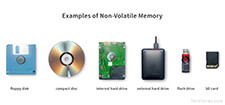Non-Volatile Memory
Non-volatile memory (NVM) is a type of memory that retains stored data after the power is turned off. Unlike volatile memory, it does not require an electric charge to maintain the storage state. Only reading and writing data to non-volatile memory requires power.
Storage devices, such as HDDs and SSDs, use non-volatile memory since they must maintain their data when the host device is turned off. Hard disks (HDDs) store data magnetically, while (flash disks|flash memory) (SSDs) store data using memory cells in integrated circuits. Both can maintain their storage state for several years without power.
Examples of non-volatile memory are listed below:
- Hard disk drive (HDD)
- Solid state drive (SSD)
- Flash drive (USB keychain)
- Optical media (CDs, DVDs, etc)
- Read-only memory (ROM)
Since most storage devices need to maintain data without power, non-volatile memory is far more common than volatile memory. In computers, volatile memory is primary used for RAM and temporary cache storage.
 Test Your Knowledge
Test Your Knowledge